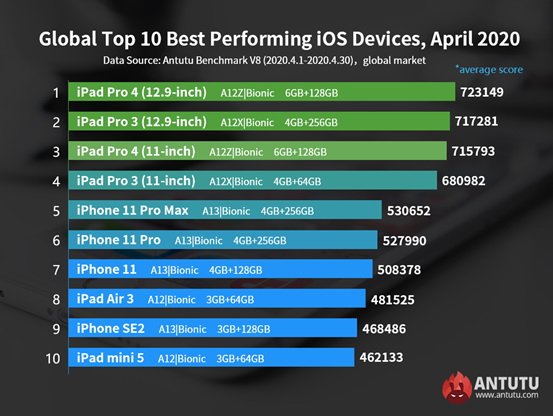A few days ago, the popular AnTuTu benchmark released the list of the most powerful Android devices. Now the company has released the ranking for the most powerful iOS devices according to AnTuTu V8.
The data collection period is from April 1 to 30, and the scores considered are all mean scores, not the highest.
In mid-March, Apple released its new generation of iPad Pro with the new A12Z chip, which will possibly be at the top of the iOS performance ranking for a long time.
Indeed, the 12.9″ iPad Pro 4 ranks first with an average score of 723,140. The previous iPad Pro 3 of 12.9″ continues in second place with an average score of 717,281, and third place is occupied by the iPad Pro 4 of 11″ with an average score of 715,793.
The 12.9″ iPad Pro 4 with the A12Z chip has added a core of GPUs relative to the base of the A12X, and therefore consists of an 8-core CPU and an 8-core GPU (the A12X is a CPU 8-core + 7-core GPU).

The performance of the A12Z is theoretically a small improvement over the A12X, leaving out unannounced factors such as frequency and processing techniques. In terms of sub-scoring, all iPad Pro 4s outperformed the older iPad Pro 3 (12.9-inch) in 3D performance, with a score difference of around 20,000 points.
The remaining seven iOS products on the list remain old acquaintances, except for the new 2nd generation iPhone SE, which comes in ninth place. There are, in order, the iPad Pro 3 of 11″ (average score: 680,982), the iPhone 11 Pro Max (average score: 530,652), the iPhone 11 Pro (average score: 527,990), the iPhone 11 (average score: 508,378), iPad Air 3 (average score: 481,525), 2nd generation iPhone SE (average score: 468,486) and iPad mini 5 (average score: 462,133).
Although they share the same A13 chip, the new iPhone SE is not far behind the iPhone 11 series. The main scoring difference between the new iPhone SE and iPad Air 3 is in 3D and UX.





